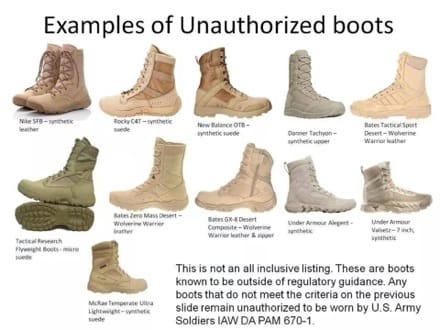SMA Raymond Chandler issues some amplifying guidance on what footwear is acceptable for wear with Army uniforms. I’m glad he has issued this guidance because he explains why certain footwear features are or are not acceptable. Regardless of whether or not you agree with the rules, this is great example of NCO leadership. It’s not just, “here are the rules”, but also an explanation of why the rules are there. His communication to the enlisted force goes a long way to explaining this graphic that has been making the rounds.
Leaders,
In this edition of my leader book notes I would like to inform leaders of the authorized and unauthorized Commercial-Of-The-Shelf (COTS) and Army issued boots for wear with the ACUs.
There has been misunderstanding with the ALARACT Message 140/2007 with leaders in interpreting which COTS boots are authorized and which are not. My intent is to add clarity to the ALARACT message giving leaders a better understanding of which boots are authorized for wear and why.
With regard to pure COTS items, Program Executive Office (PEO) Soldier and U.S. Army Natick Soldier Research, Development and Engineering Center (NSRDEC) do not have a certification process for boots. AR 670-1 and ALARACT messages provide guidance on what approved standards industry uses to manufacturer boots that are authorized for wear. This includes what material requirements have to be met to ensure boots meet the durability and performance requirements for Soldiers. These guidelines provide the aesthetic requirements to ensure any authorized items maintain uniform standards for our Soldiers.
The Army authorizes COTS boots as long as they are between 8 to 10 inches in height and made of tan rough side out of cattle hide leather, with a plain toe, and with a soling system similar in color to the tan upper materials. The soling materials cannot exceed two inches in height, when measured from the bottom of the outsole, and cannot extend up the back of the heel of the
Boot or over the top of the toe (See attached pictures), The exterior of the upper boot cannot contain mesh but must be constructed of all leather or a combination of Leather and non-mesh fabric. Boots with metal or plastic cleats in the bottom of the soles and sewn-in or laced-in zippers or velcro inserts are not authorized (See attached pictures). There are other leathers, such as pigskin, that do not meet the performance criteria of cattle hide. Cattle hide leather is more durable, and provides better performance in combat over pigskin.
Soldiers should be aware that some companies sell ‘Warrior Leather” which is a common-use name for pigskin leather. Rubber and polyether polyurethane are the only outsole materials authorized. Rubber and polyether polyurethane are the only outsole materials that currently meet the need for durability and traction on surfaces in multiple environments and temperature ranges, Other materials, which may be of a lighter weight, do not meet Soldiers performance standards.
There are many COTS items available that meet the aesthetic guidelines. Some examples of these items include, but are not limited to, the Belleville Model 390, the 8-inch Danner Desert TFX, the 8-inch Oakley S.I. Assault Boot as well as many other more traditional Army tan combat boot styles (See attached pictures). The purpose of listing these items here is to give examples of styles that fall within the guidelines and authorization as optional to wear.
PEO Soldier and NSRDEC establish high quality standards for both the end items and component materials going into our combat boots. Current Army footwear is designed to be durable and provide the functionality needed by Soldiers in current and potential future operational environments. This process ensures that Soldiers have functional boots (the NSN ones) to accomplish their mission.
PEO Soldier and NSRDEC maintain a close relationship with the footwear buyers at AAFES to ensure they are not buying anything for MCSS that does not meet the Army Uniform requirements. If AAFES has an interest in selling a specific COTS boot in MCSS, they forward PEO Soldier and NSRDEC a pair of the specified boots. PEO Soldier and NSRDEC provide the AAFES footwear buyers feedback if the boots do or do not meet Army requirements. Our Military Clothing Sales Stores stock items that are authorized for wear by other services, whose mission requirements are different than ours Because of these different mission requirements not all boots carried in our MCSSs are authorized for wear by our Soldiers.
The individual Soldier is responsible for buying authorized boots that meet Army requirements, Leaders have the responsibility of ensuring optional footwear meets Army requirements. AR 670-I, Appendix E requires all Soldiers to have one pair of each of the Clothing Initial Issue (CII) Bag item boots. This requirement includes both the Army Combat Boot (Hot Weather) and the Army Combat Boot (Temperate Weather) Any optional footwear discussed above that unit commanders authorize does not relieve Soldiers of their requirement to possess one pair of each of CII boots.
The Army develops and issues Soldiers the best equipment available for accomplishment of their mission COTS items provide a different aesthetic look compared to the NSN footwear and or contain material components that were selected for business reasons and not always aimed at improved performance.
The attached slides provide examples of authorized and unauthorized boots. These slides do not endorse these individual companies but provide leaders a method of verifying authorized boots for wear. Currently there are hundreds of companies producing desert tan boots.
Leaders, let’s make sure our Soldiers are wearing the proper boots.
Army Strong! HOOAH!
SMA

















































































































